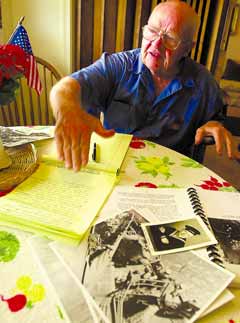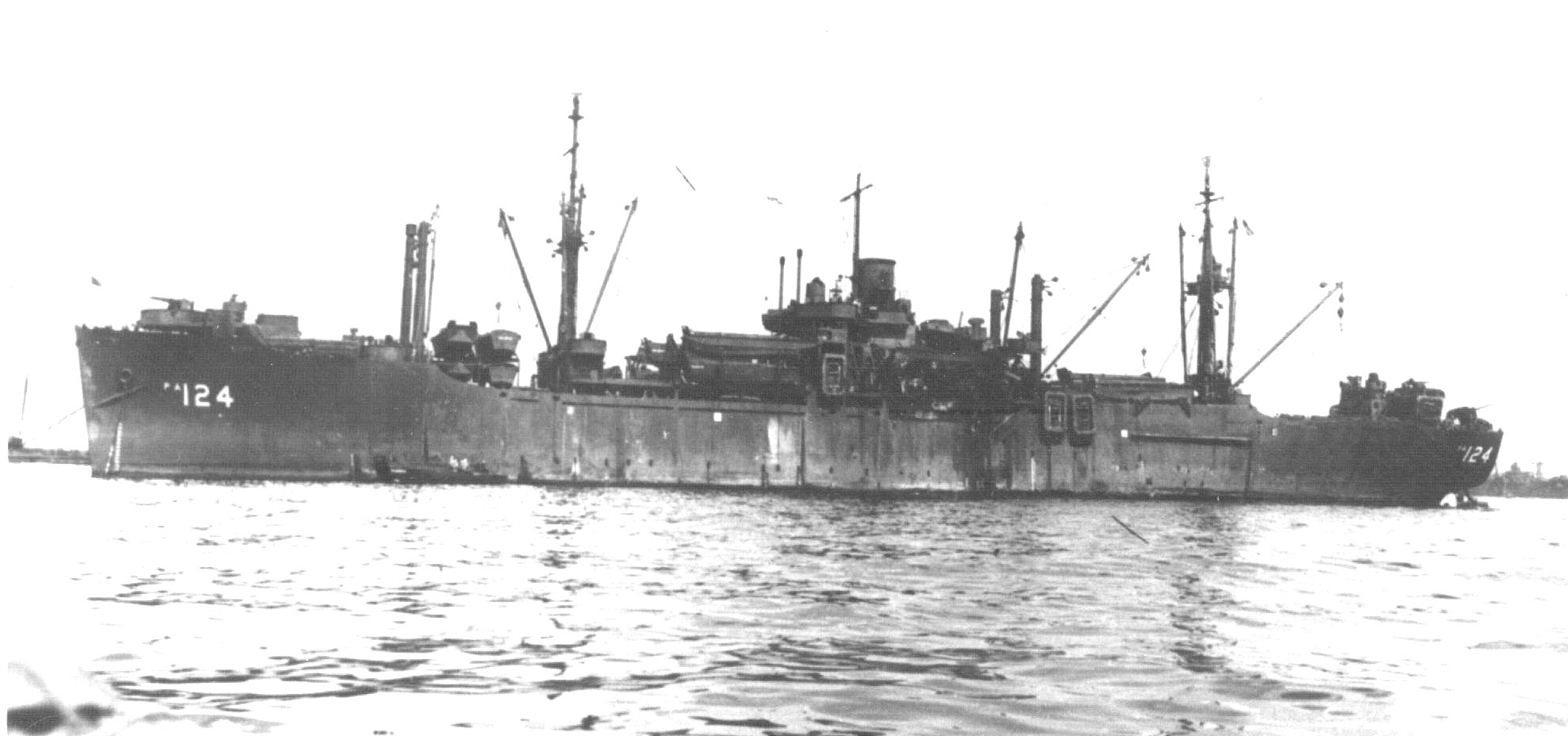

WWII Vet Recalls Kamikaze Strike

By Jeff Hunter
The Harold Journal, Logan, Utah
August 11, 2002

WWII vet Donald Wolford recalls kamikaze strike
"We were just sitting there visiting, looked out across (the bay) and here come two Jap Zeros, flying just above the waterline. From where we were sitting, it looked like they going right between our legs. I said the quickest prayer I've ever said in my life, and a couple of seconds later, Wham! "I can still remember floating through the air from the concussion."
Commissioned for less than eight months, the U.S.S. LaGrange (APA-124) has already seen its share of action in the Pacific Theater.
Seven times the troop transport ship has sent its Marines ashore, once losing a third of those men, including esteemed war correspondent Ernie Pyle, in a frightening battle for the tiny atoll of Ie Shima.
Now the LaGrange is at rest, moored in recently-renamed Buckner Bay, as the sun sets on the island of Okinawa on the evening of Aug. 13, 1945.
The Rising Sun setting, as well.
Having been devastated by a pair of atomic bombs dropped on Hiroshima and Nagasaki days earlier, the Japanese Empire is on the ropes.
The belief that Japan's surrender is imminent is so strong that the previous evening, the LaGrange , the other ships in Buckner Bay and U.S. forces on shore celebrated the end of the war with a hail of gunfire and colorful tracer bullets.
It's something worth celebrating. Not just because four long years of conflict and bloodshed are at an end, but because the much-feared invasion of the Japanese mainland with its projected 100,000 casualties is no longer necessary.
Weary from duty and the emotional release of pending peace, most of the crew of the LaGrange settles in to watch a movie in the ship's dining area.
The film: "The Flying Tigers" starring John Wayne.
"A great propaganda movie that has plenty of Japanese air attacks," a LaGrange crew member wrote decades later. "It is perhaps the tenth time that the movie has been seen by the crew. But they don't seem to care. It's free. And most important, it is a movie. The bombs and bullets are fakes. Not for real."
At 2020 hours, the scene on the movie screen is of a Japanese fighter bombing and strafing The Flying Tigers' airbase. Buildings are blowing up. Airplanes are on fire. The chaos of war.
John Wayne sprints for his plane.
As The Duke swings into action below deck, Donald Wolford and Marvin McAbee are standing watch on the port side of the LaGrange. Suddenly their view of Japanese warplanes is much better than that of their comrades at the movie.
"The Japanese pilots liked to come out of the sun, so you couldn't see them," says Wolford, a Logan native who served as a signalman on the LaGrange during the final year of the war. "But where we were sitting on that particular evening on the highest deck on the ship, we could see them as plain as plain.
"We were just sitting there visiting, looked out across (the bay) and here come two Jap Zeros, flying just above the waterline. From where we were sitting, it looked like they going right between our legs. I said the quickest prayer I've ever said in my life, and a couple of seconds later, Wham!
"I can still remember floating through the air from the concussion."
Under heavy anti-aircraft fire, the second of the Zeros hits the LaGrange high, losing both of its wings as it collides with the tall masts on top of the ship, and exploding on the other side.
But the first bomb-laden kamikaze is more successful. It hits the ship right in the center at the main deck and causes a terrific explosion, annihilating the communications room just below the bridge.
Arriving at Buckner Bay during the Battle of Okinawa, USS La Grange (APA-124) unloaded cargo needed for the final days of the war. While anchored on 13 August 1945, she came under enemy air attack and suffered the last known kamikaze attack of the war. Despite antiaircraft fire, an unidentified kamikaze carrying a 500-pound bomb crashed into La Grange's superstructure. A second suicide plane struck the top of a kingpost and splashed 20 yards from the ship. The transport suffered considerable damage in both strikes, with 21 sailors killed and 89 wounded. Japan surrendered two days later.
Written from the point of view of the LaGrange itself, Gerald M. Yankee describes the next few moments in "My Crew and I: The Story of the Last Navy Ship Casualty of World War II":
"My port side is burning. I am hit bad and I am on fire.
"All my lights go out. There is no electricity. I jump high into the air. I feel like I am clear out of the water. My entire hull shakes and shatters. The movie projector in the crew's mess flies across the room. My shaking hull seems to last forever. The crew is wondering: 'What happened?' Is this real? I hurt all over. I am boiling hot.
"At this moment, time stopped. We became part of the movie."
Knocked unconscious, time stops for Wolford.
When he comes to later in a hospital, he's initially unable to remember his name or serial number. Several hours later, the doctors ask again, and this time, he answers their questions.
"I can still remember their faces," Wolford recalls. "They were smiling like you'd never believe because that meant I was going to be OK."
McAbee and Wolford, who is cushioned from the explosion by the bag of signal flags he was sitting on, both survive. But 21 other sailors are killed, including two of Wolford's friends, Loyal Perry of Twin Falls, Idaho, and Orvil Rudd of Plymouth.
The following day Aug. 14, 1945 Japan surrenders.
According to Wolford and Yankee's book, the kamikaze attack on the LaGrange marks the last time a U.S. Navy ship is hit by Japanese forces.
Although heavily damaged, the LaGrange is quickly repaired, and is put to service returning troops to the states. Wolford also returns to work in quick time, despite shrapnel wounds in his back, other injuries to his elbow and right hip and two shattered ear drums.
Looking at a black-and-white photo of the crater left by the Zero and its 500-pound bomb, Wolford says, "I was sitting right on the edge of it. Me and (McAbee) were the closest ones to it that made it, and I don't know how we did it."
Wolford serves nearly another year in the armed forces as a guard at a Naval prison in San Francisco Bay. Upon his discharge, he returns to Logan, meets and marries his wife of 54 years, Janet, and raises five children.
Now 76 years old, Wolford is retired and lives in River Heights after careers in the U.S. Postal Service and auto body repair. His hearing now is all but gone, and he has drawn 100-percent disability from the Veterans' Administration for the last 10 years.
"Just last night I was watching television and couldn't get the sound right, but I'll be darned if I couldn't read the lips of the people," Wolford says. "I couldn't believe it. It really hit home then how lucky I've been."
Because of the damage to his inner ears, Wolford also struggles with his equilibrium. But in addition to the physical ailments, there are the psychological effects of that evening, 57 years ago.
Like many other veterans, he battles Post-Traumatic Stress Disorder "I've woke up many times in the middle of the night just sweating and dreaming nightmares," he says and the condition was understandably worsened by the events of Sept. 11.
"When I saw those suicide planes in New York, it just made me sick everything I had seen over there just flashed in front of me again," Wolford explains. "I've had a heck of a time getting those thoughts out of my head."
Looking out the window in his kitchen, Wolford continues, "Hey, we saw quite a bit of our crew hauled out in body bags. Those kinds of things, you don't just take out of your mind.
"They just stay."
Source: hjnews.com


